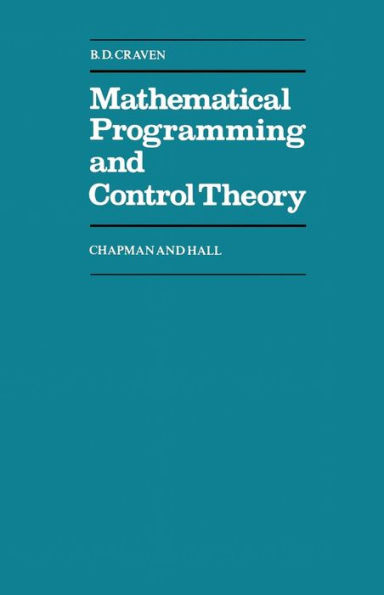5
1


Paperback
$54.99
-
PICK UP IN STORECheck Availability at Nearby Stores
Available within 2 business hours
Related collections and offers
54.99
In Stock
Overview
In a mathematical programming problem, an optimum (maxi mum or minimum) of a function is sought, subject to constraints on the values of the variables. In the quarter century since G. B. Dantzig introduced the simplex method for linear programming, many real-world problems have been modelled in mathematical programming terms. Such problems often arise in economic planning - such as scheduling industrial production or transportation - but various other problems, such as the optimal control of an interplanetary rocket, are of similar kind. Often the problems involve nonlinear functions, and so need methods more general than linear pro gramming. This book presents a unified theory of nonlinear mathe matical programming. The same methods and concepts apply equally to 'nonlinear programming' problems with a finite number of variables, and to 'optimal control' problems with e. g. a continuous curve (i. e. infinitely many variables). The underlying ideas of vector space, convex cone, and separating hyperplane are the same, whether the dimension is finite or infinite; and infinite dimension makes very little difference to the proofs. Duality theory - the various nonlinear generaliz ations of the well-known duality theorem of linear programming - is found relevant also to optimal control, and the , PREFACE Pontryagin theory for optimal control also illuminates finite dimensional problems. The theory is simplified, and its applicability extended, by using the geometric concept of convex cones, in place of coordinate inequalities.

Product Details
| ISBN-13: | 9780412155000 |
|---|---|
| Publisher: | Springer Netherlands |
| Publication date: | 10/12/1978 |
| Series: | Chapman and Hall Mathematics Series |
| Pages: | 164 |
| Product dimensions: | 5.51(w) x 8.50(h) x 0.01(d) |
Table of Contents
1 Optimization problems; introduction.- 1.1 Introduction.- 1.2 Transportation network.- 1.3 Production allocation model.- 1.4 Decentralized resource allocation.- 1.5 An inventory model.- 1.6 Control of a rocket.- 1.7 Mathematical formulation.- 1.8 Symbols and conventions.- 1.9 Differentiability.- 1.10 Abstract version of an optimal control problem.- References.- 2 Mathematical techniques.- 2.1 Convex geometry.- 2.2 Convex cones and separation theorems.- 2.3 Critical points.- 2.4 Convex functions.- 2.5 Alternative theorems.- 2.6 Local solvability and linearization.- References.- 3 Linear systems.- 3.1 Linear systems.- 3.2 Lagrangean and duality theory.- 3.3 The simplex method.- 3.4 Some extensions of the simplex method.- References.- 4 Lagrangean theory.- 4.1 Lagrangean theory and duality.- 4.2 Convex nondifferentiable problems.- 4.3 Some applications of convex duality theory.- 4.4 Differentiable problems.- 4.5 Sufficient Lagrangean conditions.- 4.6 Some applications of differentiable Lagrangean theory.- 4.7 Duality for differentiable problems.- 4.8 Converse duality.- References.- 5 Pontryagin theory.- 5.1 Introduction.- 5.2 Abstract Hamiltonian theory.- 5.3 Pointwise theorems.- 5.4 Problems with variable endpoint.- References.- 6 Fractional and complex programming.- 6.1 Fractional programming.- 6.2 Linear fractional programming.- 6.3 Nonlinear fractional programming.- 6.4 Algorithms for fractional programming.- 6.5 Optimization in complex spaces.- 6.6 Symmetric duality.- References.- 7 Some algorithms for nonlinear optimization.- 7.1 Introduction.- 7.2 Unconstrained minimization.- 7.3 Sequential unconstrained minimization.- 7.4 Feasible direction and projection methods.- 7.5 Lagrangean methods.- 7.6 Quadratic programming by Beale’s method.- 7.7 Decomposition.- References.- Appendices.- A.1 Local solvability.- A.2 On separation and Farkas theorems.- A.3 A zero as a differentiable function.- A.4 Lagrangean conditions when the cone has empty interior.- A.5 On measurable functions.- A.6 Lagrangean theory with weaker derivatives.- A.7 On convex functions.From the B&N Reads Blog
Page 1 of
